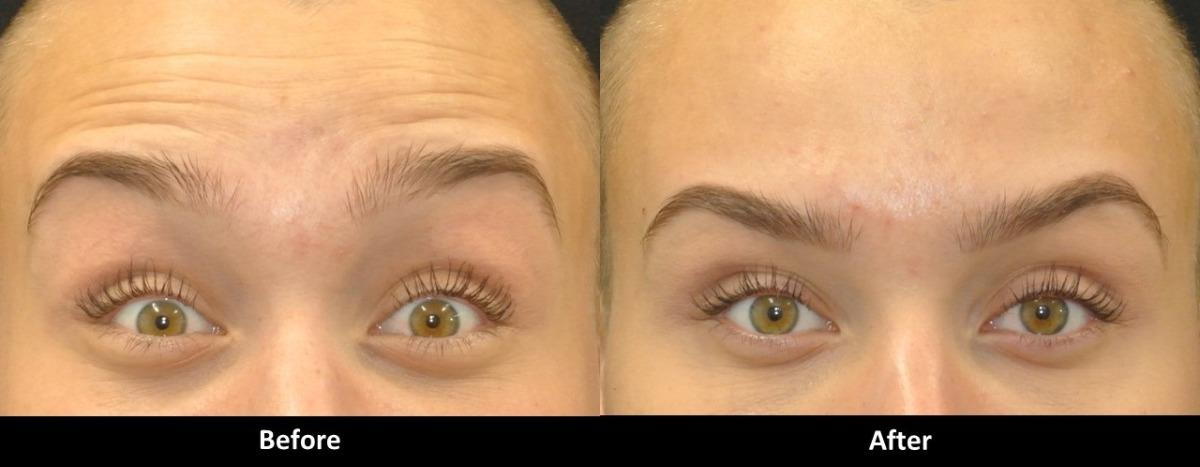
The feeling of heaviness in the eyebrows is a rare side effect of Botox treatments. Fortunately, it can be treated easily.
What is Botox?
Botox is a purified protein used to treat wrinkles caused by facial expressions. These wrinkles include the horizontal lines you see across your forehead when you raise your eyebrows, the vertical lines sometimes called elevens you seen between your eyebrows when you frown, and the crow’s feet you see around your eyes when you smile or squint. Botox works by relaxing the muscles that cause these wrinkles. You’ll see initial results from your Botox treatment in as early as a few days and you’ll see the full results in two weeks. Most people enjoy the results of their Botox treatment for three to four months. At A E Skin, we participate in the Brilliant Distinctions Program. This is a rewards program where you get points for each Botox treatment and you can use these points towards a discount at your next treatment.
How does Botox affect the eyebrows?
The wrinkles in the upper face are mostly caused by making facial expressions. You have many muscles in the face that make these expressions and Botox relaxes these muscles. When your muscles are relaxed, they can’t contract as strongly and this can affect the eyebrows. There are three main muscle areas that affect the position of your eyebrows.
On your upper forehead you have a broad, thin muscle called the frontalis which raises your eyebrows. The frontalis goes from your hairline to your eyebrows and it raises your eyebrows when it contracts. Over time, repeated contraction of the frontalis can cause horizontal wrinkles on your upper forehead. Botox treats these wrinkles by relaxing your frontalis muscle; this can make it difficult to raise your eyebrows.
Between your eyebrows you have a muscle complex called the glabella. When you contract the muscles in your glabella the inner part of your eyebrows goes downward ad inward. Repeated use of these muscles leads to vertical frown lines in this area. Botox relaxes these muscles and makes it harder to pull your inner eyebrows down.
Around your eyes you have a muscle called the orbicularis oculi. When you contract this muscle, the skin around your eyes is pulled together. If you look carefully, you’ll see the tail of your eyebrow coming down when you use this muscle to smile or squint. When this muscle is relaxed with Botox, you won’t be able to pull the tail of your eyebrow as far down as before.
How can I prevent heaviness in my eyebrows after Botox?
As discussed above, there are multiple muscles that move your eyebrows. Some move them up and others move them down. Some work on the inner part of your eyebrows while others work on the outer part of your eyebrows. If you relax only one of these areas with Botox and the other muscles are not relaxed, the position of your eyebrows can change. This is where you can get heavy eyebrows. The feeling of heaviness in your eyebrows is because it is harder to raise your eyebrows. This happens if you only relax your frontalis with Botox. People do this because they have horizontal lines on their forehead and they either don’t have frown lines or crow’s feet, or these other wrinkles don’t bother them. What happens when you do this with a Botox treatment is that the muscle you normally use to raise your eyebrows is relaxed while the muscles you use to lower them are still active. As a result, you’ll feel like your eyebrows are heavy and the position of your eyebrows may even do down. Sometimes this even affects the upper eyelids, making them look hooded. This can make it harder to apply makeup in the area. In order to prevent this side effect, it’s important to treat all of the muscles around the eyebrows. So even if you don’t have frown lines or crow’s feet, or if you do but they don’t bother you, you should still receive at least a little bit of Botox in these areas as well. This will balance the effect of relaxing your frontalis muscle with Botox and your eyebrow won’t feel heavy.
How can I correct heaviness in my eyebrows after Botox?
Heaviness in your eyebrows after Botox can be fixed in a couple of ways. If you didn’t receive Botox in your frown lines or crow’s feet or you received a low dose in these areas, more Botox can be placed here. This will relax the muscles that pull down on your eyebrows and make them look and feel less heavy. This would be recommended for future Botox treatments. Also, sometimes the Botox is placed too low on the forehead and the next time you can have the Botox placed higher on your forehead. This will prevent the feeling of heaviness in your eyebrows. You can also have a quick laser skin tightening treatment on your upper forehead. This will pull the eyebrows up and correct the heavy feeling. Sometimes you will need multiple laser skin tightening treatments and you can do them once a week.
Dr. Alex has performed over 10,000 cosmetic treatments with many satisfied patients. Contact us to schedule an appointment for a free consultation with Dr. Alex in our Encino, CA office.

